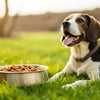What Food for Dog to Gain Weight: A Comprehensive Guide for Pet Parents
- Houndsy
Table of Contents
- Introduction
- Understanding Canine Weight and Health
- What Food for Dog to Gain Weight
- Feeding Strategies for Weight Gain
- The Role of Exercise
- Conclusion
- FAQ
Introduction
Have you ever looked at your furry friend and felt a pang of concern over their weight? You're not alone. A staggering number of pet owners grapple with the issue of underweight dogs, often wondering, "What food for dog to gain weight?" This concern is not just about aesthetics; a healthy weight is crucial for a dog’s overall well-being. Weight loss in dogs can occur for a variety of reasons, from health issues to stress, and it's vital to understand how to address this challenge effectively.
In this blog post, we will explore the nuances of canine weight gain, including the best types of food, feeding strategies, and additional tips to help your dog reach a healthy weight. Our aim is to provide you with actionable insights that will simplify and enhance your dog feeding experience, making it both convenient and enjoyable.
We will delve into the types of food that are effective for weight gain, including those rich in protein and fat, and how to incorporate them into your dog’s diet. We’ll also discuss feeding frequency, the importance of exercise, and how to monitor your dog’s progress. By the end of this post, you’ll have a comprehensive understanding of how to help your dog gain weight in a healthy and sustainable way.
Understanding Canine Weight and Health
The Importance of Weight Management
Maintaining a healthy weight is vital for dogs, as it impacts their energy levels, longevity, and overall health. An underweight dog can be prone to various health issues, including weakened immune function, dental problems, and nutritional deficiencies. Conversely, obesity can lead to joint problems, diabetes, and heart disease. Thus, achieving a balanced weight is essential for your dog’s quality of life.
Identifying Underweight Dogs
So, how can you tell if your dog is underweight? A simple method is to assess their Body Condition Score (BCS). The BCS is a visual and tactile evaluation that helps determine whether your dog is at an ideal weight, underweight, or overweight. Here are the key indicators:
- Ribs and Spine Visibility: If you can see or easily feel your dog’s ribs and spine without applying pressure, they may be underweight.
- Waist Definition: A noticeable waist when viewed from above is a sign of a healthy weight. If there is no waist, your dog may be underweight.
- Energy Levels: An underweight dog may exhibit lethargy or a lack of energy, while a healthy dog is typically more active.
If you suspect your dog is underweight, it’s crucial to consult with a vet to rule out any underlying health issues before making dietary changes.
What Food for Dog to Gain Weight
Nutritional Needs for Weight Gain
When it comes to gaining weight, the focus should be on foods that are high in calories, protein, and healthy fats. Dogs require a balanced diet to support their metabolism and maintain muscle mass, so selecting the right food is paramount.
1. High-Quality Dog Food
Look for dog foods specifically formulated for weight gain. These foods typically contain higher levels of fat and protein, making them more calorically dense. Here are some characteristics to consider:
- Caloric Density: Check the calories per cup on the label. Foods with higher caloric density allow dogs to consume more energy in less volume.
- Protein and Fat Content: Ideally, the protein should be the first ingredient, and the fat content should be higher than typical maintenance diets. Look for foods with at least 25% protein and 15% fat.
- AAFCO Compliance: Ensure the food meets the standards set by the Association of American Feed Control Officials (AAFCO) for complete and balanced nutrition.
2. Wet vs. Dry Food
Wet food often has higher palatability and can entice picky eaters. While dry food is generally more calorically dense, a mixture of both can be beneficial. For example, you can mix wet food with dry kibble to enhance flavor while still providing the necessary calories.
Suggested High-Calorie Foods
Here are some specific food options and supplements that can assist in weight gain:
- Premium Kibble: Brands like Merrick and Blue Buffalo offer high-protein, high-fat options that can support weight gain.
- Canned Food: Look for options like Wellness Core or Nutro Ultra, which provide high moisture content and calories.
- Puppy Food: Puppy formulas are richer in calories and nutrients, making them suitable for adult dogs needing to gain weight.
- Performance Diets: For active dogs, performance diets such as Purina Pro Plan Sport or Dr. Tim’s Highly Athletic provide high levels of protein and fat.
Human Foods to Supplement Your Dog’s Diet
Incorporating certain human foods can also help in achieving weight gain. Here are some nutritious options:
- Peanut Butter: A favorite among dogs, peanut butter is calorie-dense and can be mixed with kibble or served as a treat. Always choose natural varieties without added sugars or xylitol.
- Pumpkin and Sweet Potatoes: High in fiber and calories, these can be added to your dog’s meals for an extra caloric boost. Canned pumpkin (not the spiced pie filling) is a convenient option.
- Cottage Cheese: Full-fat cottage cheese is rich in protein and can be a great snack for dogs, especially those with lactose tolerance.
- Eggs: Packed with protein and healthy fats, eggs can be a nutritious addition when cooked and served in moderation.
- Fish Oil: High in omega-3 fatty acids, fish oil not only aids in weight gain but also promotes a healthy coat and skin.
Feeding Strategies for Weight Gain
Meal Frequency and Portion Control
One of the most effective strategies for helping your dog gain weight is to adjust their feeding routine. Here’s how:
- Multiple Meals: Instead of one or two large meals, consider feeding your dog three to four smaller meals throughout the day. This approach can help increase caloric intake without overwhelming their digestive system.
- Increase Portion Sizes: Gradually increase the amount of food you offer at each meal. Monitor your dog’s weight and adjust as necessary.
- Leave Food Available: For some dogs, free feeding (leaving dry food out all day) can be effective, especially if they tend to graze.
Enhancing Palatability
If your dog is a picky eater, enhancing the palatability of their meals can encourage them to eat more. Here are some tips:
- Food Topper: Add tasty toppers like bone broth, yogurt, or wet food to their kibble to make it more appealing.
- Warm Up Food: Gently warming canned food can enhance its aroma and make it more enticing.
Monitoring Progress
Regularly weighing your dog and assessing their Body Condition Score will help you track their weight gain journey. Aim for gradual weight gain—typically 1-2% of body weight per week is ideal. If you don’t see progress, it may be time to revisit your feeding strategy or consult your vet for further guidance.
The Role of Exercise
While it may seem counterintuitive, regular exercise is essential even for dogs trying to gain weight. Here’s why:
- Muscle Building: Exercise helps build muscle rather than fat, leading to a healthier weight gain.
- Increased Appetite: Physical activity can stoke your dog’s appetite, encouraging them to eat more.
- Overall Health: Regular exercise supports cardiovascular health and keeps your dog mentally stimulated.
Recommended Activities
Incorporate a mix of activities to keep your dog engaged:
- Daily Walks: Aim for at least 30 minutes of walking each day, adjusting based on your dog’s energy levels.
- Playtime: Engage in fun activities like fetch or tug-of-war to keep your dog active and entertained.
- Training Sessions: Incorporate training into playtime, challenging your dog mentally while also keeping them physically active.
Conclusion
Caring for an underweight dog requires a thoughtful approach to their diet, feeding routines, and exercise. By selecting the right food, adjusting meal frequency, and incorporating healthy supplements, we can help our furry friends gain weight in a safe and sustainable way. Remember that every dog is unique, so it’s essential to tailor your approach to fit their specific needs.
As you embark on this journey to help your dog achieve a healthy weight, consider enhancing your feeding experience with innovative products designed for convenience and efficiency. Our Houndsy Kibble Dispenser is perfect for design-conscious pet owners who value both functionality and aesthetics. With perfect portion control and a beautiful mid-century modern design, it simplifies the feeding ritual, making it easier to provide the right nutrition for your dog. Explore the Houndsy Kibble Dispenser here!.
FAQ
Q: How can I tell if my dog is underweight?
A: Look for visible ribs, a lack of a defined waist, and low energy levels. If you suspect your dog is underweight, consult your veterinarian.
Q: What types of food should I feed my dog to help them gain weight?
A: Choose high-calorie dog foods that are rich in protein and fat. Consider adding human foods like peanut butter, pumpkin, and eggs as supplements.
Q: How often should I feed my dog?
A: Feeding smaller meals three to four times a day can help increase caloric intake. Adjust portion sizes gradually based on your dog's weight progress.
Q: Is exercise important for dogs trying to gain weight?
A: Yes, regular exercise helps build muscle and can increase your dog’s appetite. Aim for daily walks and playtime to keep your dog active.
Q: How long will it take for my dog to gain weight?
A: Weight gain can take time; aim for a gradual increase of about 1-2% of body weight per week. Monitor their progress and adjust their diet as needed.












